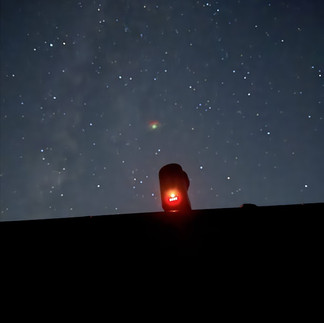Astrophotography 10/20/25
- Charlie Olson
- Oct 20
- 2 min read
Updated: Nov 6
Following one of the best clear nights, a few weeks before, I couldn't resist another night under the stars. This night was solo and primarily in the back of my truck, I was able to catch a few bright fireballs from the Orionid meteor shower. stayed out from 7pm - 6am here are my top observations!

C/2025 R2 (SWAN)
Not entirely sure how to get photos of the tails of comets yet.
Discovered on September 11th 2025 by Vladimir Bezugly of Ukraine.
Mr. Bezugly is an amateur astronomer who was using publicly released images from the Solar and Heliospheric Observatory (SOHO), specifically from the Solar Wind Anisotropies (SWAN) instrument. SWAN creates daily full-sky maps at the wavelength of hydrogen Lyman-alpha (121.567 nm, an ultraviolet wavelength). For comets, this emission appears when water released from a comet is broken apart by solar radiation into hydrogen and oxygen, and the hydrogen atoms then transition from a higher energy level to the ground state. These observations must be made from space because Earth’s atmosphere absorbs Lyman-alpha light, preventing it from reaching ground-based telescopes. Here is and example of what Mr. Bezugly was looking at!

If you would like to see the moment of discovery, here is the original discussion.
The Cocoon Nebula

This is a star-forming region about 3,300 light-years away in Cygnus. A young cluster of newly formed stars sits at its center and their radiation is lighting up the surrounding gas and dust. The bright core is surrounded by long, dark lanes of dense dust, giving it that wrapped, “cocoon-like” appearance. It’s essentially a stellar nursery: gas is collapsing, stars are igniting, and their light is slowly blowing open the cloud that formed them.
Image1, The Pleiades. Image2 telescope on car with stars. Image3 stars from Iphone

NGC 6946, the Fireworks Galaxy is a face-on spiral galaxy about 22 million light-years away, sitting on the border between Cygnus and Cepheus. It earned its nickname because astronomers have recorded an unusually high number of supernovae there in the past century. So far, ten supernovae have been observed in this single galaxy, making it nearly ten times more active than the Milky Way, despite the Milky Way containing roughly twice as many stars. Bright star-forming regions and rapid stellar evolution make it a galaxy in motion, constantly building new stars and the dramatic end of others.

The Crab Nebula (M1) is the remnant of a supernova observed in 1054 CE, located about 6,500 light-years away in the constellation Taurus. The visible filaments are the expelled outer layers of the original star, consisting mainly of ionized hydrogen, helium, and heavier elements. At the center is the Crab Pulsar, a ~30 km wide neutron star rotating roughly 30 times per second. Its strong magnetic field accelerates electrons to near light speed, producing synchrotron radiation across the electromagnetic spectrum, from radio to gamma rays. The Crab Nebula is a key object for studying supernova remnants, neutron star physics, and high-energy particle acceleration.








Comments